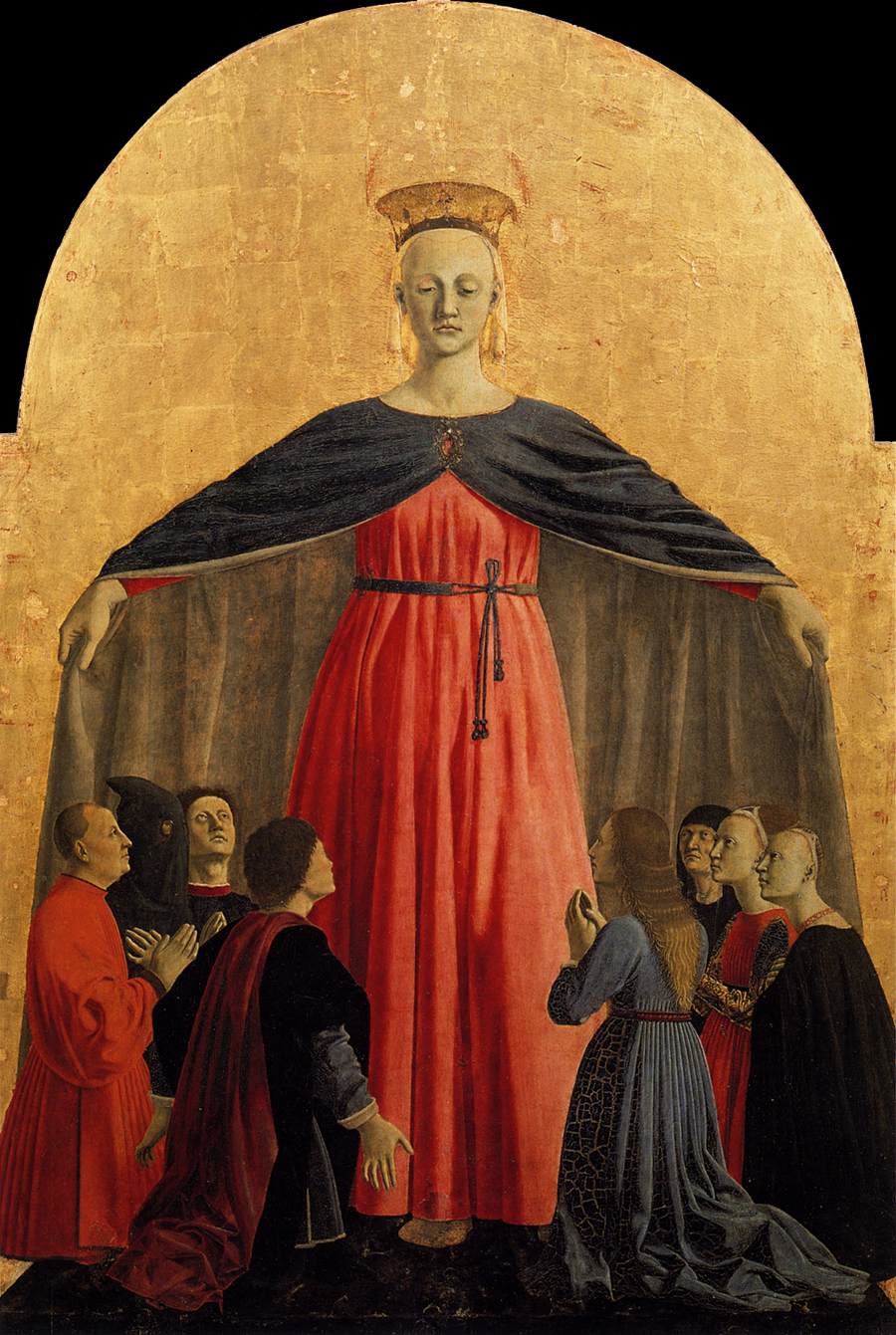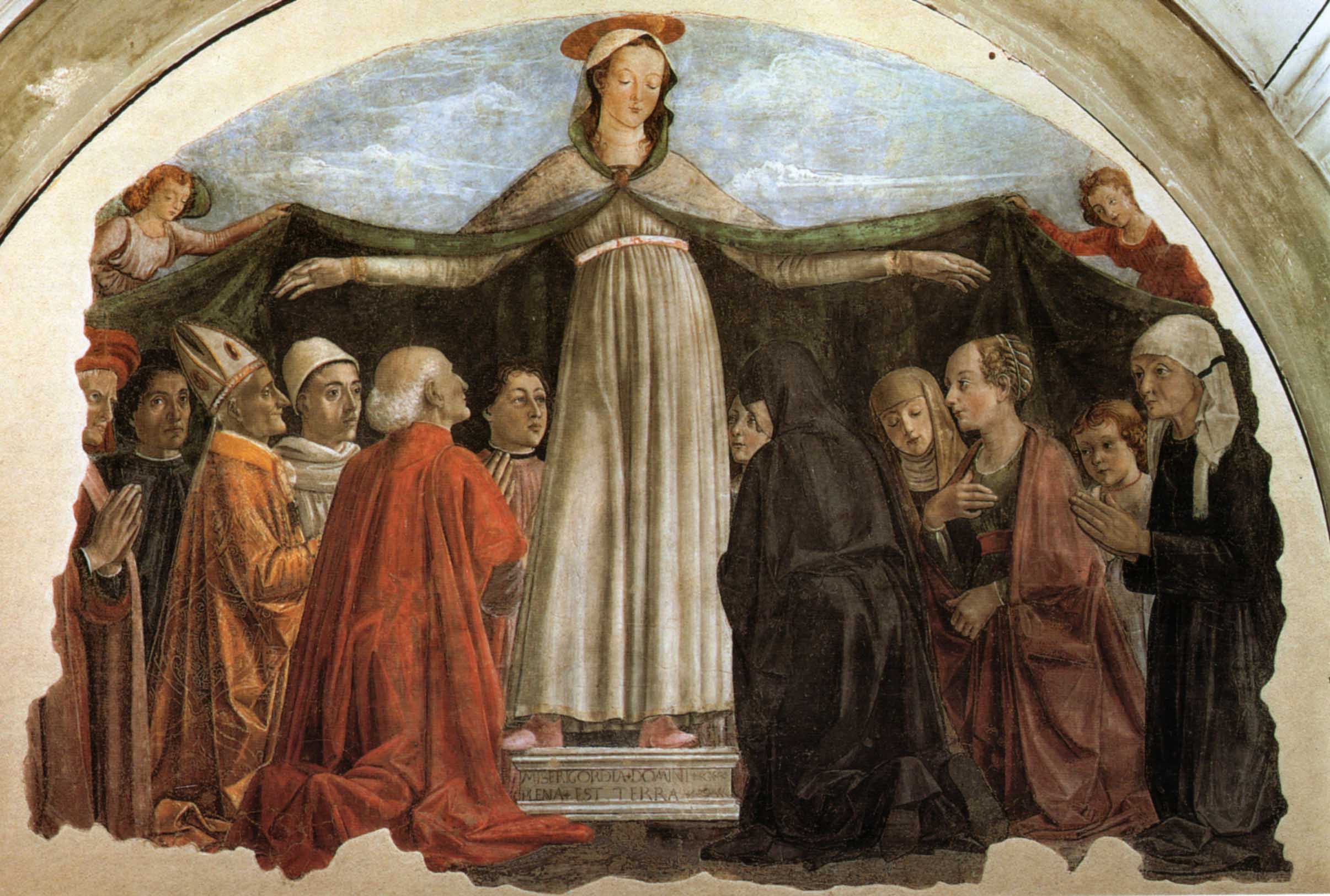The Virgin of Mercy (Madonna della Misericordia) is a Marian devotional image type recognizable by its portrayal of Mary protecting those in need and devotees under her blue mantle (cloak). Formerly celebrated on September 24 throughout the Catholic Church, the feast is now celebrated only by the Mercedarians and a few individual churches worldwide.
The Virgin is depicted standing, in large dimensions, while expanding her mantle to welcome and protect, underneath it, the kneeling faithful. The iconography was particularly successful at the medieval and Renaissance confraternities. Even after the Counter-Reformation the subject continued to enjoy a large following, for its obvious devotional connotations.
Among the historical origins of this iconographic model, we could note the medieval German Cistercian theologian and writer Caesarius von Heisterbach who, in the Dialogus miraculorum (c.1220-1230), had written about the vision of a Cistercian monk. Having been in ecstasy and transported to heaven, the monk saw the monks of Citeaux to be hidden under the folds of the wide cloak of the Virgin. This vision was soon adopted by other orders, the Dominicans, the Carmelites, and also by the Jesuits.
A few years ago a certain monk of our Order, who was particularly devoted to our Lady, while in an unconscious state experienced the contemplation of Heavenly glory. Seeing the various Orders of the triumphant Church, the Angels, the Patriarchs, the Prophets, the Apostles, the Martyrs, the Confessors, and, grouped according to their insignias, the Canons regular, the Premonstratensian Canons, the Cluniacs, he was troubled about his own Order. He looked all around but could not see anyone from his Order present in Heaven. Turning toward the blessed Mother of God, he wailed and asked: ‘Why then, most saintly Lady, do I not see any persons from the Order of Cîteaux? Why have the most devoted of your servants been excluded from these beatitudes?’And the Queen of Heaven told him: ‘Members of the Order of Cîteaux are, to the contrary, so dear and so intimate that I keep them warm under my arms.’ And opening the large and marvelous mantle which covered her, she showed him an innumerable multitude of monks, of lay brothers, and of nuns. Filled with the greatest joy, the monk gave thanks, and, his spirit having reentered his body, recounted to his abbot all that he had seen and heard. The abbot, in turn, reported the event to the abbots assembled in the next chapter. all were filled with joy and with the most ardent love for the Mother of God. [Translation of Heisterbach’s text found in: Susan Solway (1985) “A Numismatic Source of the Madonna of Mercy” The Art Bulletin, 67(3), p.360.]
Duccio di Buoninsegna, Madonna of the Franciscans, c. 1300, Tempera on wood, Pinacoteca Nazionale, Siena.
Simone Martini, Madonna of Mercy, 1308-10, Tempera on wood, Pinacoteca Nazionale, Siena.
Piero della Francesca, “Madonna of Mercy” from the Polyptych of the Misericordia, 1460-62, Oil and tempera on panel, Pinacoteca Comunale, Sansepolcro.
Domenico Ghirlandaio, Madonna della Misericordia, c. 1472, Fresco, Vespucci chapel, San Salvatore di Ognissanti, Florence.
Workshop in Marches, Our Lady of Mercy, 15th century, Wood, polychrome, Albani Diocesan Museum, Urbino.





I too had a dream of my inner madonna awakening.. While writing my analysis of the dream I searched Madonnas cloak and found your page here.
Thank you for posting such lovely examples.
S